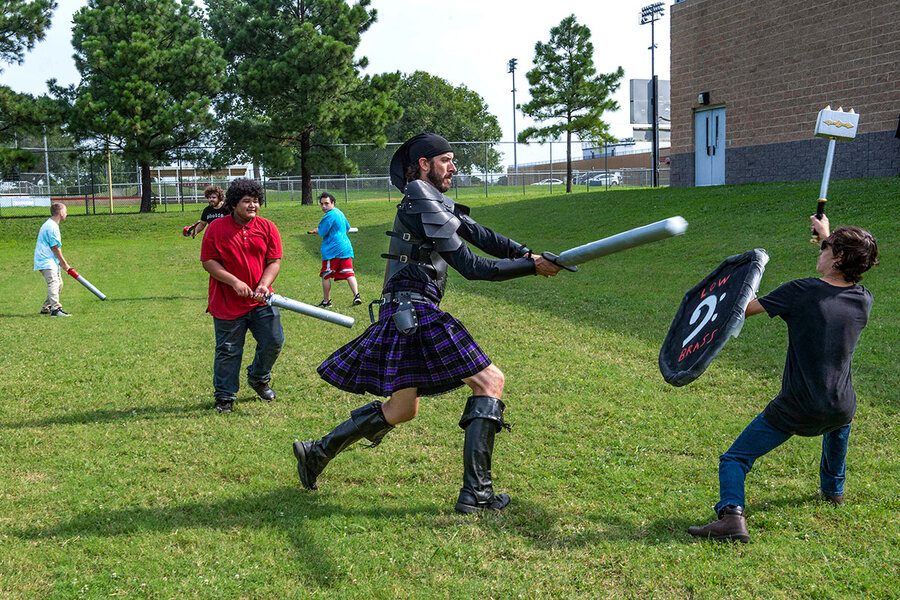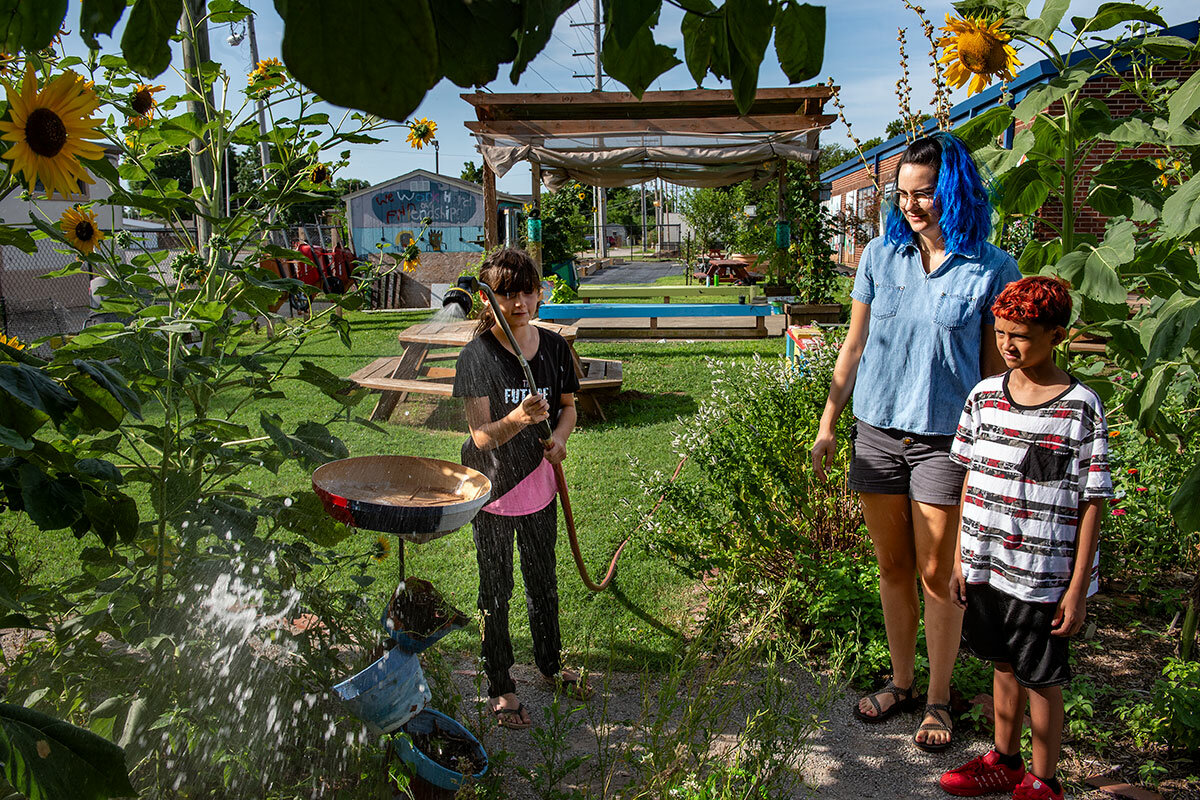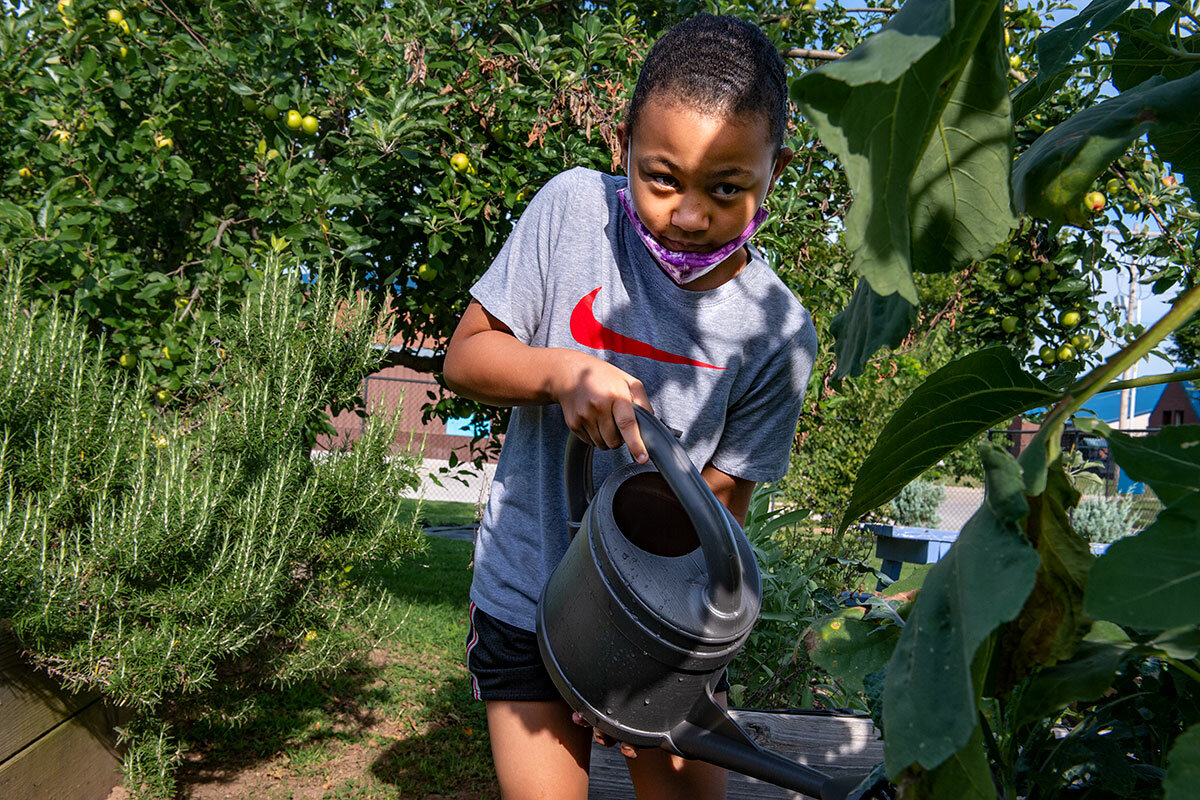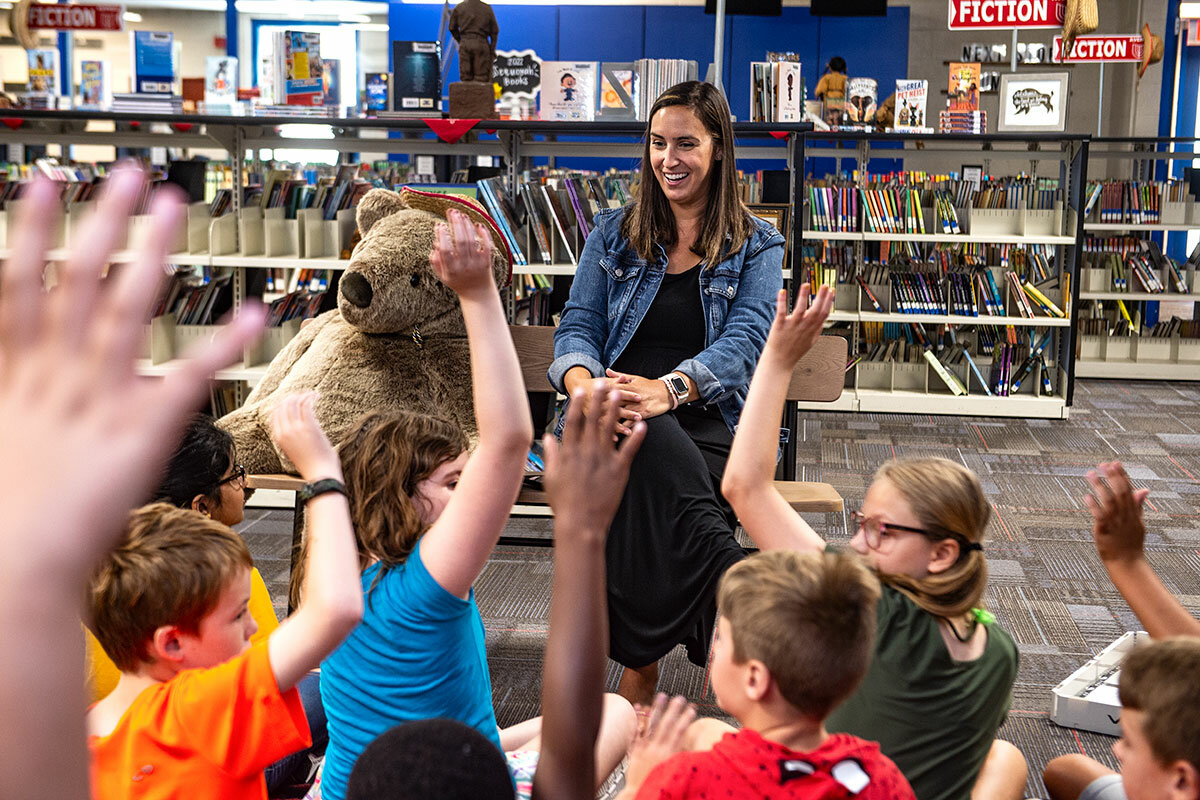Summer school re-imagined: Sword fighting, gardening, and closing the gap
Loading...
| Tulsa, Okla.
It’s 9 a.m. on a mid-July morning, but the campus of Memorial High School in Tulsa, Oklahoma, is already abuzz with activity.
Behind the gymnasium, students in the Medieval Fight Club practice sparring in a grassy field with padded swords. Under a nearby tree, teens on orange yoga mats focus on breathing deeply.
For some students, this four-week program – which also features meals and academic support – is the first opportunity to be with others in a school setting in more than a year.
Why We Wrote This
Can a summer make up for a “lost year” of education? Tulsa, Oklahoma, is one of several cities trying to re-imagine summer school in the midst of the pandemic.
“I’m pretty happy about this. I definitely have not done anything like this,” says Kianle Frazier, as he takes a break from medieval team battles. A rising sophomore, he spent his entire freshman year learning remotely, even after the school opened for in-person learning in February. “Online you don’t really interact with other students,” he says.
Summer school is the first stop in trying to get back to normal for many students this year. With federal relief funds in hand and more students signed up than usual, Tulsa Public Schools and other districts across the country are attempting to reengage young people, address emotional needs, and catch up on missed academic skills. Though maintaining funding and staffing could be hurdles in the future, for now educators are gauging the possibilities of enhanced summer programs – whether it be as a path to year-round schooling or simply a rebalancing of academics and enrichment to help student morale and education.
“We’ve taken a big step forward in imagining an expanded learning strategy that launches in the summer but continues across the school year,” says Paula Shannon, deputy superintendent of Tulsa Public Schools.
Major investments by districts
Tulsa Public Schools invested $12 million of its federal relief funds from the CARES Act and the American Rescue Plan in its summer program. Other districts in the United States are following a similar model. New York City is spending $120 million on a free summer school that’s enrolled more than 200,000 students. Cajon Valley Union School District in El Cajon, California, is running “Camp Cajon” at 27 schools.
Done well, research shows, summer school can benefit students academically and socially. District leaders in Tulsa hope that prioritizing relationships and student well-being this summer, along with providing some academic instruction, will smooth reentry mid-August. “We believe that keeping kids engaged will pay dividends in terms of their readiness to come back in the fall and actually coming back in the fall, particularly those who struggled mightily,” says Ms. Shannon.
Every school in Tulsa Public Schools this summer offers a free half- or full-day summer program from July 6 to July 30, including two hours of academic support for math and reading and at least two hours of enrichment activities – such as art and sports – run by school staff or one of the 45 community partners working with the district. Breakfast, lunch, and transportation are provided and are important in a district where 81% of students are considered economically disadvantaged.
In years prior to the pandemic, 4,000 to 5,000 of the district’s 32,000 students typically signed up for summer school. This year, enrollment more than doubled to just over 11,000 students. But, as with many summer programs nationally that struggle to retain students, site administrators at several Tulsa schools, including Memorial High, confirmed that not all enrolled students are showing up.
“The first year is going to be bumpy,” says Twanna Johnson, a social worker at Memorial High, who is running the school’s summer program. She’s disappointed that only 100 students are attending regularly, when 300 students enrolled. “I’m really hoping we can take lessons learned from this year and make it smoother.”
At Eugene Field Elementary School in northwest Tulsa, the ratio of enrollees to attendees is higher: More than two-thirds of those enrolled showed up on a recent day. Nearly 98% of the student body comes from economically disadvantaged households, according to a state profile from 2019, the most recent year available. (At Memorial High, 80% of students are identified in that category.)
On school grounds, students gathered for “Breakfast With the Birds” in a garden with towering sunflowers and leafy pink hibiscus bushes offering respite from the hot summer sun. Tomatoes, spearmint, and dill grow in student-tended garden boxes, maintained through a partnership with Global Gardens, a Tulsa-based nonprofit that provides science education and social-emotional learning for students.
Jenni Yoder, an educator from Global Gardens, samples herbs with students and invites them to help her water the plants. Later in the day she’ll teach prekindergarten and kindergarten students a lesson on bugs designed to teach science standards and life skills.
“The garden is so full of metaphors,” says Ms. Yoder. “Gardening can be disappointing. It takes patience, persistence, planning; all of those qualities help you in life.”
Paris Cooper, a rising fifth grader carefully watering a tomato plant, says she likes gardening at school since “it’s very calming and plus, you get to see friends and it’s really beautiful and there are lots of fun activities.”
Diana Warren, Paris’ mother, writes in an email that she signed her daughter up for summer school because “I wanted her to be exposed to a little bit of school work since that was lacking during the past year. I also wanted her to have some socialization with her peers because the last few months of school post-COVID just seemed to fly by.”
The new approach by Tulsa Public Schools is promising, says Curt Adams, a dean in the College of Education at the University of Oklahoma and co-founder and co-director of the Oklahoma Center for Education Policy.
“I think it’s great that the traditional summer school model is really being re-imagined,” says Dr. Adams. “We know kids learn when they are engaged, when they are curious, active, and exploring.”
How much can summer school help?
Underlying the summer school effort in Tulsa and nationally are questions about how much summer programs can catch students up on content they may have missed during the pandemic’s fractured school year. Tulsa Public Schools plans to track student enrollment and attendance in its summer program and compare math assessments from before and after the summer. School leaders expect that daily academic work will help students, but not completely close pandemic gaps.
“We are eager to see the impact that the daily [academic] intervention time will have. I don’t think it’s going to fully bridge the gap, but I think it will absolutely support students in beginning to recover unfinished learning,” says Ms. Shannon, the deputy superintendent.
Enrichment activities build knowledge and vocabulary critical to reading comprehension, educators note. Having free, district-run programs that offer those opportunities is a matter of equity, says Ms. Shannon, who points to research suggesting that students from middle- and upper-income households gain 6,000 more learning hours by sixth grade than peers in poverty, due largely to participating in extracurricular activities during the summer and after school.
Elsewhere, some commentators suggest using this moment to pivot to a year-round school calendar. Jennifer Sloan McCombs, a senior policy researcher and director of the behavioral and policy sciences department at the Rand Corp., says the research around year-round schooling isn’t particularly strong because, unlike summer school, it doesn’t increase the number of instructional days for students since vacations are still spaced throughout the year.
Dr. McCombs was a key member of the Rand team that conducted a major study looking at summer learning programs in five districts from 2011 to 2017. Her team recommended that districts offer voluntary summer programs for at least five weeks with three hours of academic instruction per day. Now, Dr. McCombs is encouraging districts to use this moment to plan for long-term summer programs, since students benefit from participating for multiple years.
“I hypothesize that what we will see is that this type of model is going to be adopted much more widely on an ongoing basis,” she says. “We may have ... districts thinking about 12 months of programming and different ways of structuring summer programs that they can offer to students and their families.”
Winning parents over may be a big lift. A nationally representative June survey from the Understanding America Study at the University of Southern California found that a majority of parents oppose a longer school year, such as more days of instruction and fewer days off, for the 2021-22 school year. It also showed only 25% of parents whose children’s schools offered summer school had signed up.
Recruiting staff is another challenge. Fairfax County Public Schools in Virginia delayed summer school for 1,200 students with disabilities because it couldn’t hire enough teachers to staff the program. Research indicates teachers enjoy summer school when pay is high, curriculum is provided, and they have small classes and flexible schedules.
Tulsa Public Schools boosted teacher pay this year from $30 to $40 per hour and hired roughly 400 certified teachers, up from 170 in 2019. The district also hired about 1,000 support staff this summer, such as teacher assistants and nurses.
Besides federal aid, this year’s Tulsa Public Schools expansion also draws on community support, including from the city and Tulsa County. In June, the district signed a $3 million, one-year contract with The Opportunity Project, a local education intermediary group to coordinate and provide enrichment programs during the summer and 2021-22 school year. (Local and national philanthropies, including the George Kaiser Family Foundation, a champion of boosting early childhood education in the city, together donated $1.3 million to The Opportunity Project to support its work with Tulsa Public Schools over the summer.)
In Tulsa, lots of experimenting
Another district that serves Tulsa students is also testing a new program. Union Public Schools, with around 16,000 students, draws about 77% of its students from Tulsa and the rest from a neighboring town.
UPS spent just over $780,000 of its stimulus funds on expanding summer school. It extended its program, which is by invitation and focused primarily on academics, from one to two months. The district also created popular stand-alone summer enrichment camps this year. Some of the elementary programs that focused on sports or STEM (science, technology, engineering, and mathematics) filled up within minutes.
At Darnaby Elementary School, in south Tulsa, nearly 44% of students are from economically disadvantaged families. Recently, 15 students who enrolled in a two-hour morning STEM camp used VexGo kits to program robots to maneuver through courses they created using colorful painter’s tape.
“What I want you to remember is how much problem-solving you did this week,” says fourth grade teacher Kristen Robinson at the end of the session. “How many of you had fun this week?” she asks as hands shoot into the air.
Sandi Calvin, assistant superintendent at UPS, says the district expects to use summer programs in tandem with other efforts, like tutoring come fall, to address learning gaps.
“This is just the beginning. We’re beefing up what we’ve done in the past. We’re looking at creative ways to deal with learning loss and some of those gaps,” says Ms. Calvin. “What we do this summer will not be the end-all and be-all.”
Back in neighboring Tulsa Public Schools, Angela Graham-Callahan, principal at Eugene Field Elementary, says summer school, with its playfulness and balance between enrichment and academic activities, gives her “great hope” for next school year.
“I see joy in the teachers,” she says. “It’s helped me clarify my vision for fall. We need to come back in a balanced way and avoid teacher and student burnout.”









